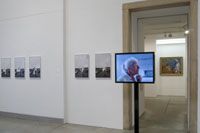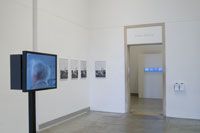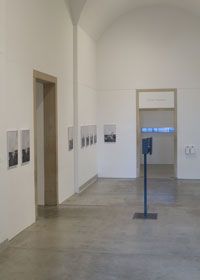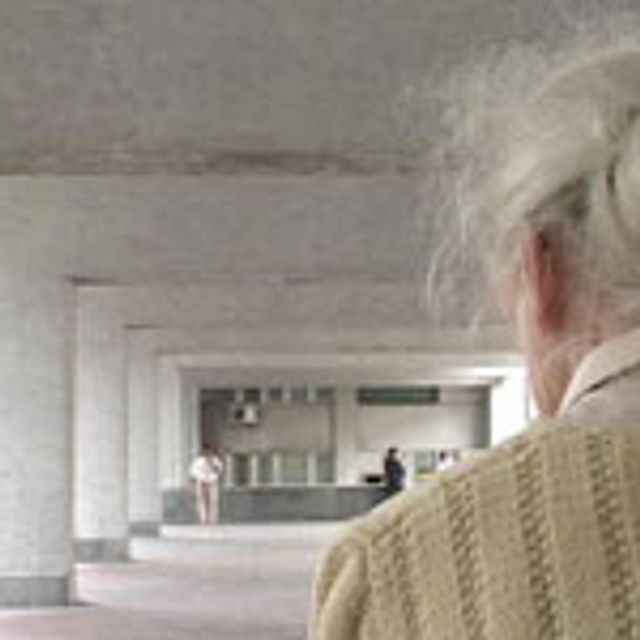Galleries 178 and 179, first floor
Main Building

Tim Hyde (American, born 1968) Untitled (Monument), 2008–09 Photo collage installation Courtesy of the artist and Max Protetch Gallery
In his work, Brooklyn-based artist Tim Hyde investigates the relationship between physical space, time, and perception. He strives to render visible the relation between spaces and the physical interactions they enable, by using architecture as a backdrop. For Hyde, space is perceived and transformed in time, a concept translated through the use of time-based mediums like video and collaged photography. The artist's close examination of the production of images in film and photography emphasizes the mechanical inadequacy of the camera, turning its technological limitations to his advantage in order to create works that challenge interpretation and question the nature of representation.
Works that build ideas of structure out of time... var f_divname="mp3player"; var f_width=133; var f_height=100; var f_file="Tim Hyde Video Panorama,Tim Hyde The Keeper,Tim Hyde Collages,Tim Hyde Connections"; var f_filetype="exhibitionMinutes"; var f_title="Video Panorama,The Keeper,Collages,Connections"; Listen to or download artist Tim Hyde's 4-part Podcast. Available in For this installment of Live Cinema, the artist has responded to the architecture of the Philadelphia Museum of Art's galleries, seemingly transforming them into a filmic device. The repetition of certain particular features in these spaces—receding walls, corners, and vaults—echoes the edgy architectural forms that emerge in Untitled (Monument), while the multiple doorways in the gallery create a dialogue with the compositional elements of The Keeper. At the same time, the extreme weather and visibility conditions captured by Video panorama of New York City during which the camera failed to distinguish the city from a snowstorm appear heightened inside the Museum's Video Gallery. Mediated by the lens of the camera, Tim Hyde's constant search for new forms of representation engages both perception and imagination.

Tim Hyde: Building in Reverse Installation view Philadelphia Museum of Art
At first sight, the blurring of the image is disconcerting as one's eyes try to adjust and distinguish the details that emerge slowly. The title of the video work comes to the rescue, stating the particular conditions at play in its making: Video panorama of New York during which the camera fails to distinguish the city from a snowstorm. Quoting the romantic tradition of panoramic landscape painting, Tim Hyde creates a portrait of a city becoming invisible in the midst of a snowstorm. He achieves this using footage filmed with a single camera moved through a 180-degree sweep over a period of seven hours and separating it into seven parts, each the record of one hour of filming. Thus, Video panorama heightens the effects of the storm as a phenomenon by emphasizing the moments in which the dense precipitations prevent the lens from focusing and instead captures its desperate pulsations as it fails to translate what it is seeing. The results are both mesmerizing and unsettling as we witness nature's unpredictable effect on the technology exposing its limitations in the process of representation. Hyde's conscious choice to fragment the already vanishing panorama by presenting it on seven different screens removes any sense of narrative from the work. It also flattens the perception of time's passing by condensing the entire duration of the storm and making it visible in a continuous, simultaneous sequence. As an artist, Tim Hyde endeavors to capture visually the effects of time's passing and to understand the role of duration in his own work. Hyde began his investigation into representation with still photography. Video followed later and brought along chance events, unplanned encounters, mistakes, failures, and unexpected discoveries. The moving image also allowed Hyde to think of time differently. If, with his still photographs, a moment in time was captured in a relatively inflexible format, with video, time becomes a malleable component that could be edited, fragmented, and manipulated into new forms of representation. Video panorama does this and more by exposing questions related to the agency of the artist at work behind the camera. The multiple-channel work explores the possibility of representing landscape in the twenty-first century when the very notion of landscape has been overly mediated and to a certain extent irrevocably compromised. In Video panorama, New York, one of the largest and most iconic modern cities, struggles against the sublime backdrop of the storm, with its physical representation, temporarily confused by the optical mechanical failure of the camera, hinging on the viewer's imagination to invoke its unique skyline. Video panorama brings to mind another memorable representation of New York's skyline over a prolonged period of time: Andy Warhol's Empire (1964), a portrait of the Empire State Building. Shot in black-and-white 16 mm film over more than eight hours, Empire is an earlier investigation into the moving image's relationship to the subjective experience of time and space. In their silence, both works assert a link with the past and the plein air observational techniques of previous generations of artists. While both films reveal the susceptibility of the cityscape to atmospheric conditions over a given time, Hyde's video takes things a step further, making temporality not only visually quantifiable but also spatially tangible through the prosthetic mediation of the camera. In addition, Video panorama increases the artist's agency, taking it to the next level: from the decision of where and for how long to point the camera, to the editorial decision to use the "compromised" footage. Presenting it in multiple fragments, Hyde heightens to an even greater extent the relationship between time, space, and the moving image.

Tim Hyde: Building in Reverse Installation view Philadelphia Museum of Art
The preoccupation with duration and its visual representation is informed by another profound interest the artist pursues in his work—that of the relationship between human presence and everyday space as it translates into image. In his 1963 films, Eat, Sleep, and Kiss, Warhol touches on the mechanism of time and space as engaged by the most mundane human activities and their production of space [Giuliana Bruno, Public Intimacy: Architecture and the Visual Arts (Cambridge, Mass.: MIT Press, 2007), 198]. Again following Warhol, Hyde pursues his method of pointing the camera at the everyday in order to capture what happens when nothing does, opening his work to accidents, confrontation, and mistakes that he welcomes and makes his own. One of these instances is The Keeper (2006), a single-channel video shot in the courtyard of a former KGB office building in Kiev, Ukraine. Drawn in by the architecture of the location, Hyde, camera in hand, intended to capture the urban perspective offered by the site and its unique features. Instead, The Keeper becomes an inadvertent portrait of a woman who responded to the camera's presence by placing herself in front of it. It is exactly this type of unexpected event at the level of human interaction that shapes Hyde's work and defines its character. The architectural elements that attracted the artist in the first place now become the background for a silent dynamic between the main protagonist and the camera. Beautifully framed by a succession of concrete arches, the head of the woman, with a slightly tousled twist of white hair, is roughly life-size and mostly viewed from the back. The woman hums a quiet melody barely audible among the cacophony of street noises that accompanies the footage. As she periodically turns to face the camera for brief moments, an instinctive interaction develops and one anticipates its evolution into verbal communication—which in the end fails to happen. It has been noted that The Keeper functions as a reversal of Warhol's Screen Tests (1964–66), "inadvertent, inverted, obstructing rather than revealing" but as compelling psychologically as its antecedents [Emily Hall, "Tim Hyde," Artforum International (April 2007), 271]. Indeed, it is the psychological aspect that captivates Hyde as the woman's presence becomes the anchor for the work, activating the space and making this accidental footage worth keeping. The movement of bodies in what is now a public space but was formerly part of a repressive institution becomes even more emotionally charged in relationship to the problematic presence of the camera as an unconcealed surveillance device. The relation between the camera as a tool of surveillance and the camera's subject also recalls Dan Graham's experimentation with video and his attempts to rebel against the medium's technological advantage while remaining subject to it. In Graham's predetermined environments, the video works exist only by virtue of the participation of a spectator confronted with his or her own image in mirror reflections or in time-delayed circuits of representation. Hyde incorporates Graham's phenomenological concerns with apparent effortlessness, due in part to the completely open situation in which he places himself and his camera. Enigmatically titled and completely unscripted, the scenario that surfaces in The Keeper reveals a complex human dimension, where tension is made even more enthralling by the tacit interaction between the woman, the camera, and the artist. As a portrait slowly emerges, it becomes unclear whether it depicts the person in front of the camera or the cityscape becoming invisible in the background.

Tim Hyde: Building in Reverse Installation view Philadelphia Museum of Art
Landscape and portraiture are not the only art historical traditions rehashed in Tim Hyde's work. Untitled (Monument) is a recent series of collaged photographs that as the title suggests, dialogues with, and challenges the monumental tradition. The collages are based on sequential photographs taken while a friend of the artist mapped out shapes in the air with a piece of construction material. These images were subsequently pulled out of order, cut into fragments and reassembled as collages in an editing process that generates implausible architectural structures. Everything about the emerging structures is a simulacra of monumentality: geometrical forms reference architectural features but do not become them; cheap foam board and plywood have an elegant appearance but cannot substitute for superior materials; solidity is attempted through the manipulation of proportions, yet a sense of instability transpires. Additionally, the play of alternating void and solid surfaces, light and shadow, verticality and flatness is unsuccessful at generating a sense of rhythmic patterns, and the carefully managed spatial sequences do not amount to an architectural climax. The deeply un-monumental nature of these structures nevertheless offers a utopian vision: that of being able to represent space and time through form in what becomes here an embodied experience. Our tactile and spatial memory is activated through the dynamic poses of the Sisyphean figure holding on his shoulders the vision of an architecture built inside time. These modules of a symbolic architecture compress time into structure by collaging fragments of the sequential photographs and disrupting the temporality contained in their orderly succession. While the chance element is still present in the multiple permutations afforded by the medium of photographic collage, Hyde takes back artistic agency by using his hands to cut and rearrange the fragments into new images. The edgy architectural forms that arise also dialogue with particular features of the gallery space where they are presented—receding walls, multiple corners, vaulted ceilings, etc.—activating the space as a filmic device. Ultimately, Untitled (Monument) is as much about the built environment's relationship to time as it is about pushing the boundaries of photography in order to transform it into a more dynamic medium. Tim Hyde's investigation of the complex relationship between time-based mediums and an embodied and subjective experience of space does not stop here, as he continues to imagine and create new forms of representation. Recently, the artist has begun working on a new body of photographs engaging directly with urban architecture and his own experience of it. One can only anticipate that this work, for which the artist has constructed a special camera contraption, will lead to fresh perspectives while maintaining the rigor of investigation that has characterized his preceding work.
Live Cinema is a series of programs in the Video Gallery of the Museum that explores the vast production of single-channel video and filmwork by a diverse group of local, national, and international artists. In the last decade an ever-increasing number of contemporary artists have appropriated these mediums as an artistic outlet, in a dialogue with the early video and Super 8 practices of the sixties and the tradition of experimental filmmaking. Each program of the Live Cinema series focuses on a specific aspect of this work, in order to both map and analyze this important facet of contemporary art production. Certain Live Cinema programs are accompanied by a brochure in which guest writers discuss the works exhibited, and also by public lectures given by the participating artists.
Galleries 178 and 179, first floor
Main Building
Tim Hyde received an MFA from Columbia University School of the Arts in 2005 and a BA in History from Vassar College in 1992. In his work, Hyde investigates the relationship between architecture, temporality and the conditions at play in the production of time-based images. Hyde's photographic and video work questions the limits of visual perception as mediated by the camera. Since 2005, his work has been included in numerous group exhibitions among them Balance and Power: Performance and Surveillance in Video Art at Rose Waltham Museum; A Tale of Two Cities, Busan Biennale; Person of the Crowd: The Contemporary Art of Flânerie at the Neuberger Museum of Art; Landscape and Affect at the Sculpture Center in Queens, NY; and more recently This is the Future before it Happened at Outpost for Contemporary Art in Los Angeles. In 2006, he participated in the Lost Highway Expedition, a project initiated by the School of Missing Studies and Centrala Foundation for Future Cities. Hyde's work is included in the collections of the Albright-Knox Art Gallery and The Ulrich Museum of Art. He lives and works in Brooklyn, NY. Live Cinema/Tim Hyde is the artist's first museum solo exhibition.

Adelina Vlas • Assistant Curator of Modern and Contemporary Art